This ICT photo-story presents a vivid account in words and images of a visit by a foreign researcher to the eastern Tibetan area of Amdo earlier this summer. The foreigner, who speaks Chinese, gives his insights on the dramatic pace of change on the plateau, from urbanization and the coming of the railway to the impact of Chinese policies in the remote rural grasslands. The researcher connects the Tibetan landscape to its recent past and China’s policies: the protests at Labrang which resulted in a monk being tortured to death and so many still in prison; the white stupa in Tsoe where the grandfather of the 7th Gungthang Rinpoche self-immolated in 2012; the Chinese trinket-sellers cashing in on Tibet chic’ in a monastery town. The researcher chose to remain anonymous.
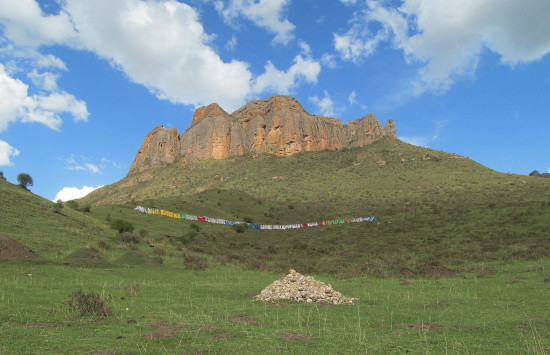
High peaks and pure earth in northern Tibet.
As my plane touched down in Chengdu, capital of China’s Sichuan province, I wondered what I would find on my return to Tibet. My destination was Amdo, the northernmost region of Tibet, which is divided into supposedly “autonomous” prefectures in Sichuan, Gansu, and Qinghai provinces today. Since my last visit these areas have witnessed enormous demonstrations, harsh crackdowns, and dozens of self-immolations. Over the following two weeks I traveled through tiny villages and big cities, speaking to nomads, monks, and shopkeepers in Mandarin and Tibetan about their lives in Chinese-occupied Tibet. What I found illustrates the paradox China faces in Tibet: even while Beijing tightens its grasp and transforms the country, their efforts are failing on a human level. All across Tibet, people are openly and courageously displaying their discontentment with Chinese rule and their longing for the return of the Dalai Lama.
Sometimes the transformation of Tibet is a physical presence, visible to the naked eye. An hour or two outside of Xining, just beyond the noise and construction of the newly-constructed city of Ping’an, the landscape begins to change into something identifiably Tibetan. But as prayer flags and stupas begin to proliferate by the side of the road, so too do pylons, work crews, and the other signs of railway construction. Hours to the east the same work can be seen in the narrow river valleys connecting Tsoe (Chinese: 合作, Hezuo) with the first major town beyond the border of northeastern Tibet, Linxia.
[mgl_gmap mapid=”trip” lat=”34.092076000000006″ long=”102.64007600000001″ zoom=”6″ width=”100%” height=”380px” skin=”retro” controls=”pan,zoom,scale,overviewMap” ][mgl_marker lat=”30.615046″ long=”104.076538″ ]Chengdu[/mgl_marker][mgl_marker lat=”36.629471″ long=”101.769409″ ]Xining[/mgl_marker][mgl_marker lat=”35.494947″ long=”102.291260″ ]Gartse[/mgl_marker][mgl_marker lat=”35.196986″ long=”102.530212″ ]Labrang[/mgl_marker][mgl_marker lat=”34.811154″ long=”102.696381″ ]Amchog[/mgl_marker][mgl_marker lat=”34.981234″ long=”102.906494″ ]Tsoe[/mgl_marker][mgl_marker lat=”34.092076″ long=”102.640076″ ]Taktsang Lhamo[/mgl_marker][/mgl_gmap]
The Tsoe-Linxia line could be a case study in the harmful side-effects of careless railway construction, especially horrifying given the fragile environment of the high Tibetan plateau. Formerly a green river valley filled with flocks of grazing sheep and goats, the way is now dominated by both the rail bed and the debris resulting from its creation. Smaller flocks of sheep try to squeeze into thin strips alongside the tracks; Tibetan villages have been chopped up and bisected. The environmental and social impacts from this line have been so severe that even China’s notoriously unstoppable railway ministry was briefly forced to a halt following an order from the Ministry of Environment Protection in 2013. Work seems to be moving forward again now, but bigger questions about who stands to benefit and who’ll lose out when the railroad is finished remain unaddressed.
Arriving in Sangchu town (Chinese: 夏河, Xiahe) one notices just how quickly the Chinese ‘quarter’ has grown over the last few years- perhaps it could more fittingly be called a Chinese ‘half’ now. New apartment buildings dwarf everything on the Tibetan side of town, while a faux-Tibetan town square is getting some finishing touches next to the river. One also notices the new signs dutifully hoisted over every shop, hotel and restaurant in Sangchu. The government-designed placards cement Chinese as the dominant language in this purportedly “autonomous” Tibetan prefecture, with Tibetan printed in tiny letters above the Chinese characters. English lettering on the bottom is simply a transliteration of the Chinese, producing garbled Tibetan names and leaving the functions of each shop unclear to those who can’t speak Mandarin. Throughout the rest of the prefecture bilingual signage laws are openly violated, or the spirit of the law is ignored, as is the case with highway warning signs where Tibetan is printed at a tiny fraction the size of the Chinese, leaving it almost certainly illegible to a passing driver.
Tibetans themselves, on the other hand, remain proudly Tibetan. In Sangchu and in the small grassland towns nearby- Gartse, Gangya, Sangkhog- Tibetans blast in off the highways riding motorcycles fitted with small Tibetan carpets over the seats, wearing long-sleeved chubas and carrying knives in their belts. Old men and women sit in the shade, spinning prayer wheels and gossiping. Pilgrims circle the monasteries and slowly inchworm their way between towns, moving a few feet forward with each prostration. Monks lean on each other under the midday sun while a throng of students fan out to pick up litter under the direction of their teachers. They ask me about America, and roar with pride when I ask if they like living in Tibet.
The landscape is incredibly beautiful as spring turns into summer. Prayer flags and lhatse top the peaks, high above the green fields and white stupas which fill the valleys below. Getting to a lake called Tarzang Tso requires the navigation of a steep switchbacked road up into the mountains, passing clumps of blue wildflowers and Tibetan villages with broad stone walls. In the grasslands the mountains gradually give way to endless vistas, bright blue skies, and air so clean it elicits palpable relief from anyone who has endured so much as one day in the choking smog of a Chinese mega-city.
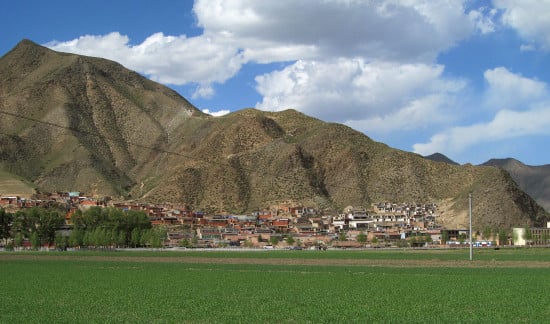
The west side of Sangchu town.
Even here the land is being scarred, though, and an enormous mining operation outside of Amchog (Chinese: 阿木去乎, Amuquhu) brings that same question to mind: who benefits from this, and who is being left to pick up the tab? In Machen county, just a few hours away, backlash is building over a Chinese mining company operating in the Tibetan area of Golog which has been spewing unfiltered runoff directly into the Machu River. If the mighty Machu (which becomes the Yellow River once it flows down into China) is fair game for unchecked pollution, what recourse do herders and villagers in a little-known town have against environmental devastation?
The reality of harsh retribution limits what some people will say. One man says he wants to talk about politics but is afraid, telling me that a Tibetan was beaten to death by Chinese police for talking to foreigners not too long ago. The situation is “so so bad” for Tibetans these days, he says as we part. Many others are bold, and men and women of all ages and backgrounds repeatedly tell me that it’s impossible for Tibetans to get passports these days. I keep running into Tibetans who have spent a few years in India, many of whom wanted to secure a better education than they could get in Chinese territory, or to spend time near the Dalai Lama. With passports restricted and border security increased, the number of Tibetans to successfully make their way to Nepal these days is a small fraction of what it used to be. It’s disturbing to think that Chinese authorities would cut off this lifeline by means of naked ethnic discrimination.
In Taktsang Lhamo (Chinese: 郎木寺, Langmusi) rows of two-story buildings line the road in various states of completion. Soon the town will be twice its current size. A shopkeeper tells me he worries his hometown will soon look like Dali or Lijiang, tourist meccas in Yunnan whose original occupants have been pushed out to make way for rows of identical souvenir shops. The Bai and Naxi have lost their hometowns to the demands of the Chinese tourism industry, and already one can see bits of that change happening in Taktsang Lhamo- roughly a dozen shops have appeared over the last three or four years selling generic “ethnic” “handicrafts,” items which have little identifiable connection to the Tibetan ethnicity and almost certainly weren’t crafted by hand. The man points out the few shops still owned by Tibetans- one here, one across the street, one down the block. The rest are owned, and in many cases staffed, by Chinese migrants.
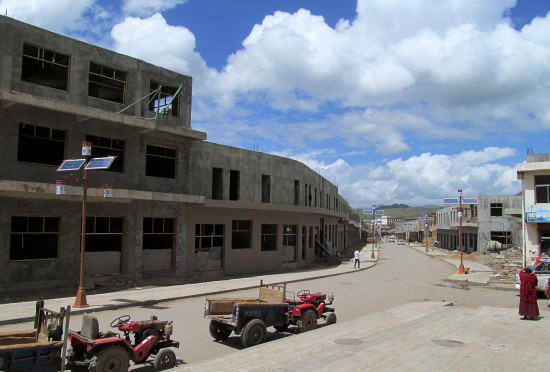
Construction in Taktsang Lhamo.
I’m told a story illustrating the frustrations local Tibetans have with Chinese migrants. Some Chinese employees in souvenir stores have taken to wearing Tibetan clothing and jewelry in an attempt to mislead Chinese tourists and hopefully get them to spend more money. One day a tourist comes into a shop having just seen the monks debating in nearby Lhamo Kirti monastery. Unsure of what the monks were doing, he takes the Chinese employee for a Tibetan and asks if the monks were fighting. The employee, unsure himself but not missing a beat, replies “Yes they were! Our Tibetan monks are violent and extremely unruly.” Many locals are unhappy to see migrants disrespecting and belittling their culture like that. The topic may be especially sensitive in light of government narratives which portray the Tibetan clergy as irrational and in need of stricter Communist Party control.
Looking at the portraits propped up in temples, shops, restaurants, and homes, one can see how much of the simplest parts of day to day life in Tibet are decided by capricious Party diktats and the police organs which enforce them. In one town police have decided that portraits of the Dalai Lama are unacceptable, and his face can be found only in quiet locations far from the beaten path. In another town just a few hours away the ban on his image isn’t enforced, and Tibetan shopkeepers rejoice in putting his picture in the most prominent places. “We miss him so much,” one woman tells me.
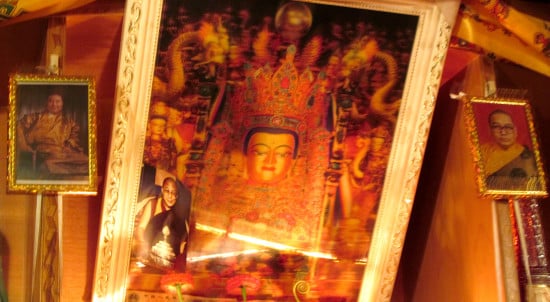
The 10th Panchen Lama, 14th Dalai Lama, and 6th Jamyang Shepa.
Another portrait is uniformly impossible to find: that of Gyaltsen Norbu, the Chinese-picked boy referred to as the 11th Panchen Lama by Beijing. I hadn’t expected to see much of him, but the degree of his absence was still striking, the sole exception being a small picture stuck to the outside wall of a temple in Labrang. In contrast, pictures of the beloved 10th Panchen Lama are far more numerous; I lost count around 150. These numbers speak to the way Tibetans have rejected the alternate reality Beijing foists upon them, one in which people like the Dalai Lama and Gedhun Choekyi Nyima, the legitimate Tibetan-recognized Panchen Lama, aren’t allowed to exist. The force required to maintain this alternate reality is visible every day, whether it’s in the form of a line of police carrying riot shields and guns down the main street in Sangchu, a forest of cameras set up to monitor Labrang monastery, or the pervasive registration requirements and police checkpoints along the roads.
Lhamo Kirti monastery swarms with young novice monks, and after morning classes end they spread out along the river to eat snacks and play games. Pilgrims spin prayer wheels as they walk past a new prayer hall under construction. Just minutes away Sertri monastery glimmers with golden rooftops and an even more picturesque setting, but it’s eerily quiet compared to Kirti. Curious, I ask around and learn that Kirti is home to 1,100 monks and a huge number of novices, while Sertri is home to just 350. It turns out the abbot of Sertri has taken to scolding the Dalai Lama on behalf of the Communist Party, earning the monastery heaps of government funding but squandering the respect of local monks and laypeople.
This kind of official favoritism isn’t unique in Tibet, where a handful of monasteries like Sertri and Ganden Sumtseling in Gyalthang (Chinese: 香格里拉, Xianggelila) have reaped enormous financial benefit by siding with the Party. Meanwhile, Lhamo Kirti has long-standing connections with Ngaba Kirti, a stronghold of Tibetan national sentiment and early epicenter of the Tibetan self-immolation protests. A group of monks eating lunch in town proudly tell me about the history and various branches of the Kirti monastic system, speaking disdainfully of Sertri monastery and its “pro-Party” abbot. Another group of monks invite me into their quarters, which boasts a huge poster with pictures of everyday items and their proper Tibetan names. It’s there to help keep them from lapsing into Chinese, part of an effort to preserve the use of their mother tongue in daily conversation.
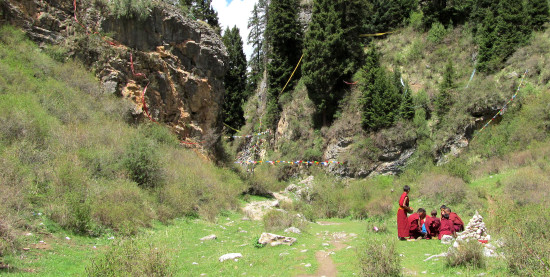
Novices picnic behind Lhamo Kirti.
Lhasa sometimes overshadows the rest of Tibet in the foreign imagination, but traveling through Amdo it’s clear how deeply interconnected the different areas of Tibet are today. In Terlung monastery a group of pilgrims jump off a bus and begin to tour the monastery- not pilgrims from the grasslands on their way to Lhasa, but rather pilgrims from Lhasa touring the monasteries of Amdo. They moved through the monastery with particular intensity, throwing khatas (white ceremonial scarves) onto the arms of a giant statue, prostrating before images of Buddhist deities, and leaving piles of offerings on the altars. As I walked beside one woman she paused her quiet repetition of “thug je che, thug je che, thug je che” (“Thank you, thank you, thank you”) to indicate that I should do the same. When in Tibet… “Thug je che, thug je che, thug je che.”
Next to one of the monasteries there’s a compound holding a hostel, Tibetan restaurant, tea house, and thangka gallery. Established by a monk from Golog, the buildings and their interiors are fine examples of Tibetan architecture and decoration, and the food is delicious: Tibetan staples like yak-meat momos, sha balep (fry-bread), and tsampa. The staff is almost entirely Tibetan, and a young man sitting in the restaurant lobby plucks the strings of a traditional Tibetan dranyen. It’s refreshing to see such a distinctly Tibetan enterprise enjoying commercial success. Meanwhile, a look through Norlha provides another glimpse of Tibetan modernity: incredibly high-quality yak wool scarves and clothing made by nomads using traditional techniques sell for upwards of $100. Other stores sell chubas with modern twists and smartphone cases with Tibetan designs.
New buildings in Tsoe, the capital of Kanlho Tibetan Autonomous Prefecture, gleam in the bright sun. Two large statues, one of a yak and the other of some chiru (Tibetan antelope), dominate a park that stretches along the central boulevard. The Hui Muslim community is thriving in this town, which has expanded steadily southwards over the last few years. The grandest sight here is indisputably the Milarepa Lhakhang, a towering multi-story temple on the grounds of Tsoe Ganden Choeling monastery. Not long after my visit Tsoe showed up in the news when over 100,000 Tibetans gathered for a Buddhist teaching called the Kalachakra empowerment, given by Setsang Rinpoche, the widely-respected abbot of Tsoe monastery. Thousands of armed Chinese paramilitary police arrived shortly thereafter, filling the boulevard and intimidating the crowds.
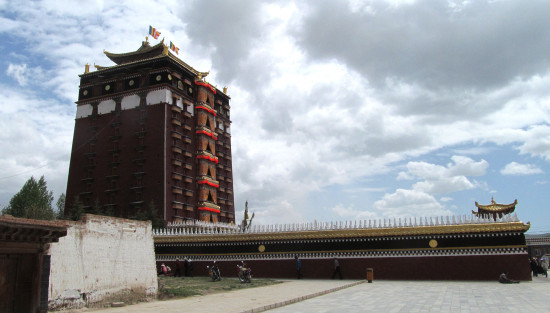
Tsoe’s Milarepa Lhakang.
Back in the big Chinese cities near the northeastern edge of Tibet, Tibetans form a small but visible minority. Khampa Tibetans from Yushul sell yartsa gunbu (caterpillar fungus) in shops, although business has taken a hit lately and many of these shops are now shuttered. One man from Rebgong tells me that life is “terrible” for Tibetans there, and he can’t wait to move back to his hometown. It’s worth noting that ‘China Dream’ propaganda, a campaign started by Communist Party secretary Xi Jinping, has been plastered all over walls in Lanzhou and Xining. But despite the presence of so many Tibetans, Mongols, and Hui in these cities, the propaganda remains unadapted to their languages and cultures. It’s still the China Dream, which apparently has no interest in entertaining questions about the Tibetan Dream, the Mongol Dream, the Hui Dream. Even in Lhasa, in the square in front of the Jokhang Temple, the art used in China Dream billboards is Chinese. Red Chinese characters proclaim that “the Chinese Communist Party is good.”

‘China Dream’ propaganda in Lanzhou.
During the 1950s and the Cultural Revolution, tens of thousands of Tibetans were murdered and jailed. Many died of hunger. These are historical facts. No one can wipe them out. Even in the 21st century, Tibetan people have not gained equal rights to pursue their own language, commerce, politics and environmental work. Such inequalities are clearly visible to the naked eye and have caused much resentment in the hearts of Tibetan people. Therefore, since 2008, a series of non-violent protests have rocked the Tibetan plateau. In fact more than 90 Tibetans have set themselves on fire in an act of tragic protest. For these reasons, the Chinese government must find out a viable solution to assuage the resentment of the Tibetan people. Guns and armored vehicles, imprisonment and torture, demonisation and curses will never succeed in pacifying the Tibetan people.
In many places a tourist today could walk right past the site of protests without seeing a single sign of what really happened: the main street in Labrang, where enormous peaceful demonstrations erupted in 2008; the school in Luchu where the Chinese flag was torn apart and replaced by the Tibetan flag for a few short hours; the white stupa in Tsoe where the grandfather of the 7th Gungthang Rinpoche self-immolated in 2012, and indeed the sites of self-immolations in so many of the towns and monasteries in the area: Labrang, Luchu, Machu, Sangkhog, Amchog, Bora, and Lhamo Kirti. One Tibetan, a tough man who had walked through the Himalayas in order to spend a few years of freedom in India, told me that “although things seem calm here now after the protests in 2008 and the self-immolations, Tibetans are really more upset than ever.” The Party should consider taking some time off from printing up propaganda asserting their popularity; on the ground the situations looks completely different.

